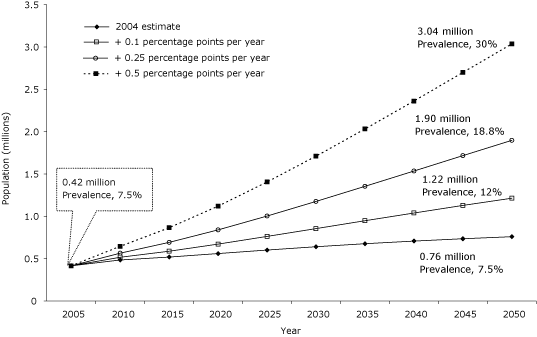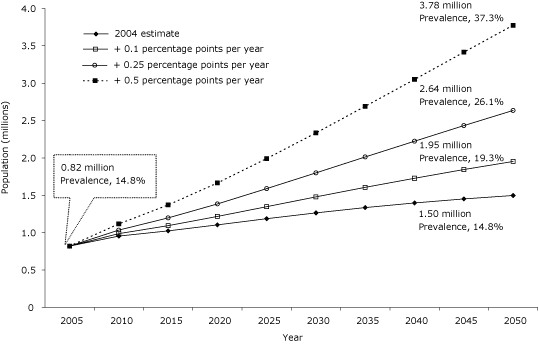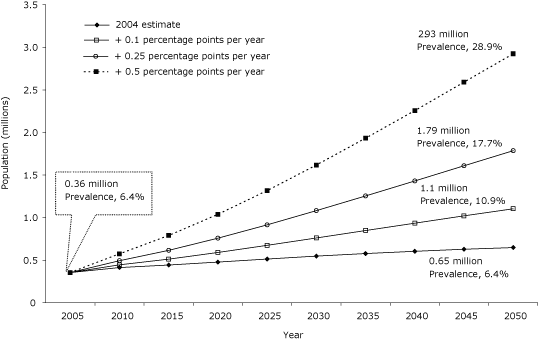

|

|

Volume
6: No. 2, April 2009
LETTER
Projected Burden of Chronic, Noncommunicable Diseases in Jordan
Suggested citation for this article: Brown DW, Mokdad AH, Walke H, As’ad M, Al-Nsour M, Zindah M, et al. Projected burden of chronic, noncommunicable diseases in Jordan
[letter]. Prev Chronic Dis 2009;6(2):A78.
http://www.cdc.gov/pcd/issues/2009/
apr/08_0162.htm. Accessed [date].
PEER REVIEWED
To the Editor:
Noncommunicable diseases (NCDs) are a global challenge. During the next several decades, NCDs will govern the health care needs of populations in most low- and middle-income countries
because of declines in communicable diseases, conditions related to childbirth and nutrition, changes in lifestyle factors (eg,
smoking), and population aging (1). We examined the burden of NCDs in the Hashemite Kingdom of Jordan. We
computed the projected prevalence of diabetes,
hypertension, and high blood cholesterol. All of these risk factors are associated with an increased risk of cardiovascular disease (CVD) — the leading cause of death in Jordan — and increased health care use.
In 2005, Jordan’s population was approximately 5.5 million. By 2050, the
population is expected to increase to between 8.5 and 14.8 million people. (2) The proportion of older people (aged 60 years or older) is expected to be 15.6%
(or approximately 1.8 million people) in 2050, more than 3 times that in 2000 (2).
During 2005, NCDs accounted for more than 50% of all deaths in Jordan. Heart disease and stroke (International
Statistical Classification of Diseases, 10th
Revision, codes I00-I99) accounted for 35% of
all deaths; malignant neoplasms (C00-C97) were responsible for 13% of deaths (3). Nearly 60% of deaths from malignant neoplasms occurred among people younger than 65 years,
and approximately one-third of those who died from CVD were aged 65 or younger.
During 2004, approximately 400,000 (15%) Jordanian adults had diabetes (an
increase from 7% in 1996),
and an estimated 350,000 (12%) had impaired fasting glucose (4,5). Approximately
15% of adults reported hypertension, and roughly 23% had high blood cholesterol — an increase from 9%
in 1996 (4,5).
We computed crude estimates of the growing prevalence of NCD risk factors using Jordan’s projected population estimates from 2005 through 2050 (2).
We analyzed hypertension, high blood cholesterol, and diabetes prevalence estimates collected from a household survey in 2004 (4,5). For each risk factor, population projections were multiplied by the risk factor prevalence estimates
(based on self-reported physician-diagnosed disease) to obtain the projected population with diabetes, hypertension, or
high blood cholesterol for each time period.
The projected population in Jordan from 2005 to 2050 with diabetes, hypertension, or
high blood cholesterol is shown in Figures 1 through 3. Four possible scenarios are displayed in each graphic. The first scenario applies the 2004 estimated risk factor prevalence and assumes that this prevalence remains constant. Each of the remaining scenarios starts with the 2004 estimated prevalence and applies a 0.1, 0.25, or 0.5 percentage point annual increase to the projected population
estimates. These increments are somewhat arbitrary because they are not based on past experience in Jordan but
reflect possible annual increases in prevalence.

Figure 1. Projected population with diabetes mellitus in
Jordan from 2005 to 2050 according to 4 different projected prevalence variants. Figure generated by the authors using data from the Population Division of the Department of Economic and Social Affairs of the United Nations Secretariat (2) and Zindah et al (5).
[A tabular version of this figure is also
available.]

Figure 2. Projected population with
hypertension in Jordan from 2005 to 2050 according to 4 different projected prevalence variants. Figure generated by the authors using data from the Population Division of the Department of Economic and Social Affairs of the United Nations Secretariat (2) and Zindah et al (5).
[A tabular version of this figure is also
available.]

Figure 3. Projected population with high blood
cholesterol in Jordan from 2005 to 2050 according to 4 different projected prevalence variants. Figure generated by the authors using data from the Population Division of the Department of Economic and Social Affairs of the United Nations Secretariat (2) and Zindah et al (5).
[A tabular version of this figure is also
available.]
The projected population in Jordan with each risk factor during 2050 ranged from 0.76 to 3.04 million
people for diabetes, from 1.50 to 3.78 million for hypertension, and from 0.65
to 2.93 million for high blood cholesterol depending on the 4 possible scenarios noted above. For
example, assuming the prevalence of diabetes observed in 2004 remained at 7.5%
through 2050, approximately 750,000 people in Jordan would be expected to have
diabetes in 2050 (all other things being
equal) (Figure 1). If the prevalence of diabetes increased at 0.5 percentage points
per year during the period, approximately 3 million people, or 30% of the
Jordanian population, would be expected to have diabetes in 2050
(all other things being equal).
Our crude estimates suggest that approximately 1 to 3 million people in Jordan will have diabetes, hypertension, or
high blood cholesterol by 2050 depending on changes in disease prevalence and the growth of the
population. There are at least 4 limitations to our study: the initial
prevalence is based on self-reported disease status and therefore may
underestimate the true prevalence; many people will have multiple risk factors
that increase their risk for heart disease and stroke; the annual increments in prevalence were arbitrarily chosen and not based on past experience in Jordan; and we did not take into
account differences in age-specific risk factor prevalence over time.
Similar risk factor patterns exist across the region. The proportion of all
deaths attributable to NCDs in the World Health Organization's Eastern
Mediterranean Region is projected to increase from 51% during 2005 to 66% by 2030 (6). Assuming prevalences
are similar to that in Jordan, diabetes may affect nearly 10 million people in
Egypt, one of the region’s largest countries, and 3 million people in Saudi
Arabia. Hypertension may affect 18 million Egyptians and 6.5 million people in Saudi Arabia by 2050.
Programs to monitor and control risk factors, clinical services, and a robust
health care system will be important to successfully improve NCD outcomes and
reduce the burden of disease. Reducing the prevalence of NCDs will require a renewed commitment by governmental and nongovernmental institutions, by public health professionals and clinical practitioners, and by communities and individuals to
acknowledge the burden of NCDs and the need for timely action. Moreover,
stimulating, strengthening, and sustaining regional efforts and programs are necessary to reduce the
prevalence of NCDs through coordinated and integrated programs of health promotion and disease prevention. These programs should involve networks for risk factor surveillance, information sharing, capacity building, advocacy, policy development, and collaboration in generating, disseminating, and applying
knowledge.
David W. Brown, MScPH, MSc
Centers for Disease Control and
Prevention
National Center for Chronic Disease Prevention and Health Promotion
Atlanta, Georgia
Ali H. Mokdad, PhD
University of Washington
Institute for Health Metrics and Evaluation
Seattle, Washington
Henry Walke, MD
Centers for Disease Control and Prevention
Coordinating Office of Global Health
Atlanta, Georgia
Majed As’ad, MD
Jordan Ministry of Health
Amman, Jordan
Mohannad Al-Nsour, MD
Jordan Ministry of Health
Jordan Applied Epidemiology Programme
Amman, Jordan
Meyasser Zindah, MD
Jordan Ministry of Health
Amman, Jordan
Kamal Arqoob, MD
Jordan Ministry of Health
Amman, Jordan
Adel Belbeisi, MD
Jordan Ministry of Health
Assistant Secretary General
Amman, Jordan
Back to top
References
- Mathers CD, Loncar D. Projections of global mortality and burden of disease from 2002 to 2030. PLoS Med 2005;3(11):e442.
- Population Division of the Department of Economic and Social Affairs of the United Nations Secretariat. World
population prospects: The 2006 revision. New York (NY): United Nations;
2007.
- Directorate of Information Studies and Research, Ministry of Health, The Hashemite Kingdom of Jordan. Mortality in Jordan 2005. Amman
(JO): Ministry of Health, The Hashemite Kingdom of Jordan; 2008.
- Mokdad AH. Health issues in the Arab American community.
Chronic diseases and the potential for prevention in the Arab world: the Jordanian experience. Ethn Dis 2007;17(2 Suppl 3):S3-55-56.
- Zindah M, Belbeisi A, Walke H, Mokdad AH.
Obesity and diabetes in Jordan: findings from the Behavioral Risk Factor Surveillance System, 2004. Prev
Chronic Dis 2008;5(1).
http://www.cdc.gov/pcd/issues/2008/jan/06_0172.htm.
- Projections of mortality and burden of disease
to 2030.
Geneva (CH):
http://www.who.int/healthinfo/statistics/bodprojections2030/ en/index.html.
Accessed July 16, 2008.
Back to top
|
|
